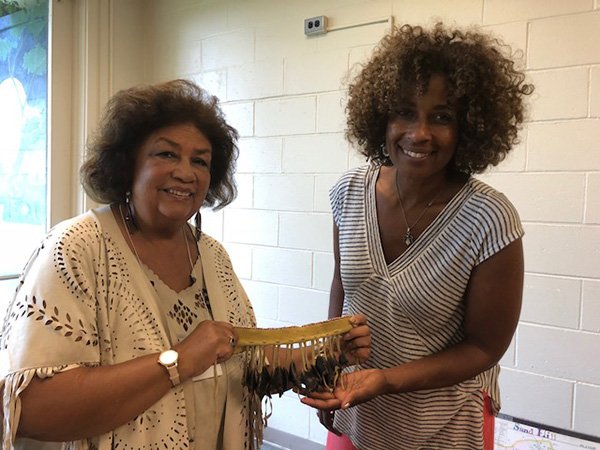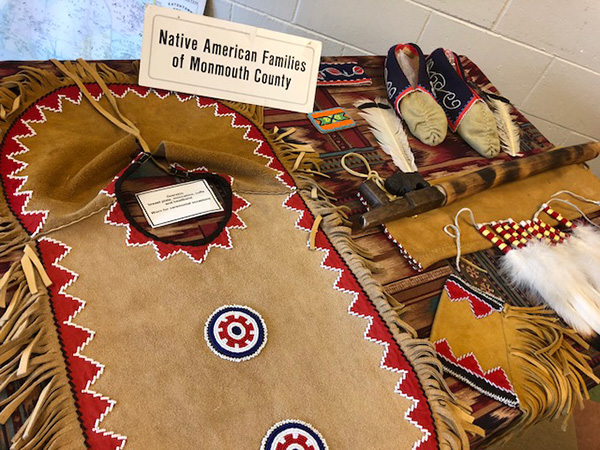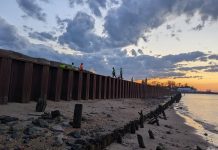
By Rick Geffken |
Hundreds of years before the Oyster Point Hotel and Marina was built on the banks of the Navesink, a band of Lenape feasted on those succulent shellfish and left behind a huge 30 ft. wide by 15 ft. high midden of oyster shells. These piles of shells were found all along the Bayshore and helped archaeologists determine much about how our Native American predecessors lived on our Two River estuaries, according to Claire Garland.
Garland, the director of the Sand Hill Indian Historical Association, gave an informative talk, “500 Years on the Navesink” at the Eisner Memorial Red Bank Public Library on Saturday, August 11th. She brought along her sizable collection of artifacts from her Native-American ancestry – leather shirts and pants, a feathered fan, gourd rattles, and pictures of her Revey family ancestors, whom she dates to 1780. Their heritage lingers in a section of Tinton Falls still called Reveytown, along and around Shafto Road in that borough. It was named for Thomas Revey during the 19th century.

Sand Hill in Neptune was the location of one of her ancestor’s homes. The area near today’s West Bangs Avenue is occasionally used for family reunions, including one with over 75 people just a few weeks ago.
“History didn’t begin here with Columbus in 1492,” Garland told the attentive audience of adults and children. “European fishing boat crews in the 13th century were trading with natives along the coast down through Massachusetts.” Indians, as they were wrongly described by Columbus and other explorers, even further south were aware of these strange looking men sailing along their coastal waters.
Garland’s ancestry is a mix of native Lenape, Cherokee (who had moved from Georgia to New Jersey), and colonial Dutch. The Revey family included many artisans who created traditional clothing and other useful articles to help support themselves. Lenape influence on European culture after first contacts was substantial in surprising ways. “When the European started arriving in the New World, they dressed in shorty-sorts and high stockings,” noted Garland. “They quickly learned to wear leather pants like the Indians to prevent briars from cutting their legs.”

Place names, or “Indian talk” as Garland called it, that we take for granted now were originally Lenape designations – Wanamassa, Mantoloking, Manalapan, Manasquan, Wickatunk, and yes, even Navesink and Rumson. The last two derived from variations of the name of the Navesinck band of Lenape and from the peninsula they referred to as Narumsunk.
Garland pointed out that the late Paul Boyd (Atlantic Highlands, From Lenape Camps to Bayside Town) believed that the shell middens he found about every eight miles along the shoreline indicated Indian villages about a day’s walk from each other. Until Europeans appeared, Native Americans believed in communal rights to property with everyone share in the land’s riches. When the Indians “signed” deeds (mostly by making a mark like an X), they thought of them like leases. The European concept of hard rights to property essentially let the Europeans steal land. The New Jersey State Archives has preserved over 800 of these deeds.
An interesting aspect to Garland’s talk was her assertion that during the last Ice Age, the water captured as ice at the north pole reduced the Atlantic Ocean to the extent that our coastline was a further 80 miles out from today’s. She claimed that Native Americans built villages and houses on this extended shelf, though few remains of them have ever been found.
Other revelations from Garland included that the Turtle Clan of the Lenape occupied most of the middle section of New Jersey in our area. “Lenape people hunted seals, whales, porpoises. They supplemented their diets with fruit like apples, quince, and beach plums. Europeans were in awe of the abundance in the local estuaries here. They sent letters back home encouraging more settlers to come to the New World where they would find ‘a whole cellar of food.’”
Garland also mentioned, seemingly without rancor, that “The County of Monmouth took 105 acres of my family’s property at Reveytown to construct the Reclamation Center along Shafto Road.” One wonders if the pungent odor in the area is something of a Lenape revenge.
For more about Garland’s Revey and Sand Hill Indian ancestry, see www.SandHillIndianHistory.org.














